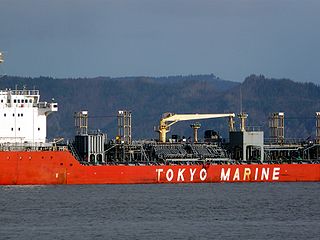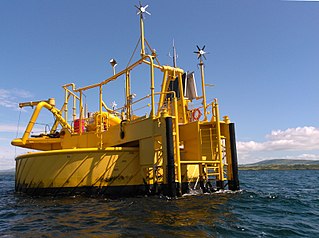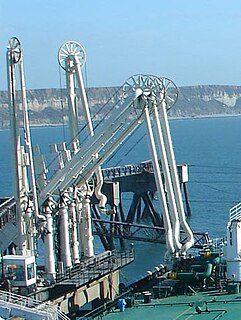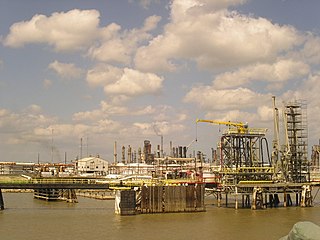
The Port of Anchorage (POA) is a deep-water port located in Anchorage, Alaska with 3 bulk carrier berths, two petroleum berths, and one barge berth. It is an enterprise department of the Municipality of Anchorage. As such, the Port is distinguished from other types of municipal departments largely because it generates enough revenue to support its operations without being a burden to Anchorage property tax payers, and it also pays a fee-in-lieu of taxes to help run city government.

A dry bulk cargo barge is a barge designed to carry freight such as coal, finished steel or its ingredients, grain, sand or gravel, or similar materials. Barges are usually constructed of steel. They have an outer hull, an internal void that is fitted with heavy struts and cross braces or scantlings, and an internal cargo box. The outer hull of a barge can come in one of two configurations. A rake barge has a curved bow to provide less resistance when being pushed and is usually placed at the head of the tow. A box barge is usually placed in the center and rear of the tow and can hold more cargo.
Shipbroking is a financial service, which forms part of the global shipping industry. Shipbrokers are specialist intermediaries/negotiators between shipowners and charterers who use ships to transport cargo, or between buyers and sellers of vessels.

A chemical tanker is a type of tanker ship designed to transport chemicals in bulk. As defined in MARPOL Annex II, chemical tanker means a ship constructed or adapted for carrying in bulk any liquid product listed in chapter 17 of the International Bulk Chemical Code. As well as industrial chemicals and clean petroleum products, such ships also often carry other types of sensitive cargo which require a high standard of tank cleaning, such as palm oil, vegetable oils, tallow, caustic soda, and methanol.

A tanker is a ship designed to transport or store liquids or gases in bulk. Major types of tankship include the oil tanker, the chemical tanker, and gas carrier. Tankers also carry commodities such as vegetable oils, molasses and wine. In the United States Navy and Military Sealift Command, a tanker used to refuel other ships is called an oiler but many other navies use the terms tanker and replenishment tanker.
Crowley Maritime Corporation, is based in Jacksonville, Florida. Founded in 1892, Crowley is primarily a family- and employee-owned marine solutions, energy and logistics services company, providing services globally. As of July 2016, Crowley was ranked as the 13th largest private company in Florida, employing approximately 5,300 people worldwide with revenues of $2.2 billion. It provides its services using a fleet of more than 300 vessels, consisting of RO-RO vessels, LO-LO vessels, tankers, Articulated Tug-Barges (ATBs), tugs and barges. Crowley's land-based facilities and equipment include terminals, warehouses, tank farms, and specialized vehicles.

SS Petersburg (T-AOT-9101) is one of Military Sealift Command's two US Government-owned tankers and is part of the 35 ships in the Prepositioning Program. It is part of Maritime Prepositioning Ship Squadron Three. Its normal crew complement is 38 civilians and no military personnel.
Lightering is the process of transferring cargo between vessels of different sizes, usually between a barge and a bulker or oil tanker. Lightering is undertaken to reduce a vessel's draft in order to enter port facilities which cannot accept very large ocean-going vessels. Lightering can also refer to the use of a lighter barge for any form of short-distance transport, such as to bring railroad cars across a river. In addition, lightering can refer to the process of removing oil or other hazardous chemicals from a compromised vessel to another vessel to prevent oil from spilling into the surrounding waters.
Petroleum transport is the transportation of petroleum and derivatives such as gasoline (petrol). Petroleum is transported via rail cars, trucks, tanker vessels, and through pipelines. Which method is used to move this oil depends on the amount that is being moved and its destination. The biggest problems with moving this oil are pollution and the chance of being spilled. Petroleum oil is very hard to clean up and is very toxic to living animals.

A Single buoy mooring (SrM) is a loading buoy anchored offshore, that serves as a mooring point and interconnect for tankers loading or offloading gas or liquid products. SPMs are the link between geostatic subsea manifold connections and weathervaning tankers. They are capable of handling any tonnage ship, even very large crude carriers (VLCC) where no alternative facility is available.

An oil tanker, also known as a petroleum tanker, is a ship designed for the bulk transport of oil or its products. There are two basic types of oil tankers: crude tankers and product tankers. Crude tankers move large quantities of unrefined crude oil from its point of extraction to refineries. For example, moving crude oil from oil wells in Nigeria to the refineries on the coast of the United States. Product tankers, generally much smaller, are designed to move refined products from refineries to points near consuming markets. For example, moving gasoline from refineries in Europe to consumer markets in Nigeria and other West African nations.

A marine loading arm, also known as a mechanical loading arm, loading arm, or MLA is a mechanical arm consisting of articulated steel pipes that connect a tankship such as an oil tanker or chemical tanker to a cargo terminal. Genericized trademarks such as Chiksan are often used to refer to marine loading arms.

W. L. Steed was a steam tanker built in 1917–1918 by Bethlehem Shipbuilding Corporation of Quincy for Pan American Petroleum and Transport Company, with intention of transporting oil and petroleum products between Mexican and Gulf ports and the Northeast of the United States. The ship was briefly requisitioned by the US Government during World War I but returned to commercial service in early 1919. The ship was named after William L. Steed, superintendent of the Mexican Petroleum Company of California.
ship-to-ship (STS) transfer operation is the transfer of cargo between seagoing ships positioned alongside each other, either while stationary or underway. Cargoes typically transferred via STS methods include crude oil, liquefied gas, bulk cargo, and petroleum products. The nomenclature STS transfer should be used in reference to techniques used by civilian merchant vessels, as differentiated from underway replenishment which is the term used by the US Navy for similar, but usually far more complicated, operations between naval vessels while underway.

SS Mount Washington was one of four Offshore Petroleum Discharge System (OPDS) tankers. The Mount Washington was one of the largest of the fleet - 736 feet (224 m) long, a beam of 102 feet (31 m), and a fuel capacity of 364,000 bbl (57,900 m3). Built in 1963 for the commercial trade, the Mount Washington was turned over to the Maritime Administration in 1987 and was placed into the Ready Reserve Force as one thirteen 'Common User Tankers' that can be activated in the event of National Emergency.

The cargo control room, CCR, or cargo office of a tankship is where the person in charge (PIC) can monitor and control the loading and unloading of the ship's liquid cargo. Prevalent on automated vessels, the CCR may be in its own room, or located on the ship's bridge. Among other things, the equipment in the CCR may allow the person in charge to control cargo and stripping pumps, control and monitor valve positions, and monitor cargo tank liquid levels.
SS Arrow was built by Bethlehem Steel Company, Sparrows Point, Baltimore, Maryland in 1948 as the tanker Olympic Games. Renamed the Sea Robin in 1960 and finally to Arrow in 1962, the ship was a Liberian-registered tanker. At 551.2 feet in length, 68.3 feet in width, and a draft of 29.9 feet, she was an enlarged version of the standard American wartime tanker design and one of the oldest tankers in the fleet of Aristotle Onassis, owned by the Sun Navigation Company. The Arrow ran aground and spilled its load of oil into Chedabucto Bay on February 4, 1970. It remains the most significant oil spill off Canada’s East Coast Only the MV Kurdistan comes close when that vessel spilled about 6,000 tons of oil after breaking apart just south of Cabot Strait on March 15, 1979.














